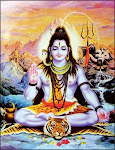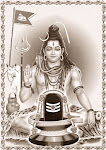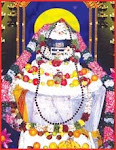



Saint Manickavasagar... Thiruchendoor... Thiruparamkunram... Palani
Hinduism
Thiruvembavai Festival :
Awakening of the universe from its slumber
Kalabhooshanam Chelvatamby Maniccavasagar
Hindu Religion functions to regulate the allocation of moral responsibility between self and others. The moral concept of wrong and right, just and unjust is covered by religious doctrines. Saivism introduced the concept of “belief in a just world” which means a world in which people get what they deserve and deserve what they get.
The humble expression of Saint Manickavasagar reveals the moral functions of faith in God. Further, the religious beliefs are associated with attributions of responsibility for justice. Thus faith in God helps to reduce anxiety over unjust situations and with the help of God, it is possible for him also to come up in life.
Though Saint Manickavasagar thought he was not a suitable person to be a devotee of God, yet God accepts him as his devotee. God is his father’ and Mother. In fact, all the hymns of devotional literature substantiate the role of Hindu religion as a means of reducing anxiety, providing understanding of death, attributing responsibility for justice and enhancing group solidarity.
Thus the function of religion in this regard is to help enhance the quality of life. According to great Saint Manickavasagar God is the Lord of the universe, God is the Supreme Spirit, creator of beings and ruler of the universe. Whatever manifests as being, goodness and power, all such in reality is an expression of some bit of his boundless energy.
St. Manickavasagar in all humility placed himself as His absolute bondsman when the growing love takes possession of him. He looks upon the Lord of the worlds with tenderness of a loving devotee and craves for the tender care and love of a father and mother in one.
Furthermore, the Thiruvembavai festival which is celebrated for ten days in all the Hindu Temples and homes commences during the rainy months of December - January. The chief figure of Thiruvembavai festival is Saint Manickavasagar with his sacred Thiruvasakam. The Saint’s life story “Thiru Vathaur Adigal Puranam” is read during these nine days. Early, in the morning of the tenth day, is the “Nadarasar Dharshanam” or “Aruthir” exposition.
During the “Thiruvembavai” festival special rituals are performed daily in all temples and Hindu homes. The day commences with the singing of Thirupalli Elluchchi Hymns awakening God from His Slumber (ie) “Emperuman Palli Elunta Arulaaye”. In the opening lyric Saint Manickavasagar recites that Lord Shiva as embodiment and personification of spiritual light and wisdom with neither a beginning nor an end.
In fact, this “Thiruvembavai” or the “Mystic song of the Maidens” is said to have been composed by Saint Manickavasagar for the use of maiden. During the rainy cold months of December - January the females of the village and city of all ages for ten successive days rise before dawn and perambulate the precincts, arousing their companions from house to house and proceeding to bathe in the sacred tank.
Indeed, their prayers are well expressed in the 10th stanza of the Saint Manickavasagar’s Thiruvembavai verses:
“Older are thou than the oldest of all
Newer of all that is new,
At thy Saint’s feet we in service will fall,
We are thy hand maidens true,
None but thy bondsmen shall call us their own,
Lord, we would none others wed,
We would be slaves at their bidding alone
So be our bliss perfected - Elorembavay”
In fact, there is also a mystic interpretation to the observance, in which the month of “Margali” (December - January) is considered the symbol of awakening of the universe from its slumber of involution. It is the dawn of the new creation of secular evolution. Further, the temple of Nadarajah in Holy Chidamparam draws large crowds of Hindus for Dharsanam and the Thiruvembavai poojas are performed at Thillai with great solemnity. Those who have visited the Holy Shrine during Thriuvembavai festival will know how the maidens song of the dawning is celebrated in honour of Lord Shiva and Sakthi in the month of Margali. The songs recited by these maids are full of praise for Lord Shiva true to nature and still more beautiful are the passages and comes across in the songs. God and Truth are synonymous: those who are spiritually inclined will read the songs discerning God, truth and Beauty.
Furthermore, it is difficult to pick or choose any one of the twenty songs as the best since all the songs are equally important. The first song begins with the praise of Lord Shiva (Represented by the light) who has neither beginning nor end awakening from sleep the maidens who are still sleeping sweet and yet clinging to their beds in the early hours of the morning and the curtain drops with the praise by Him to whom can be traced the creation, existence and dissolution of the whole universe including human beings. According to Saint Manickavasagar in “Thiruvembavai” and “Thiruvasagam” that Lord Shiva becomes accessible to the devotees whose hearts melt with tears while uttering or listening to His glory.
Saint Manickvasagar’s culture, philosophy, social consciousness and literary excellences are still seen in Tamilnadu. The mind that is attached to objects of enjoyment makes for misery while it fetches release when detached from them.
In fact, prayer and devotion have been watchwords to beckon people away from the path of misery, anguish, distrust and hate and lead us on the path of understanding.
--------------------------------------------------------------------------------
Understanding Hinduism -10:
Thinking in Abstract terms
K. S. Sivakumaran
My understanding of Hinduism is limited within my understanding capability.
Having visited some of the neighbouring Indian cities for 40 days which included my voyage to Puttaparthi in the Andhra Pradesh, I returned to my native country as a little more informed of what the real life is in most pars in the subcontinent. Although my journey was in pursuit of understanding the varied cultures and lifestyles in the world through the medium of Cinema, I also benefited by learning to be spiritualistic.
In the first place, let us pose a question.
Has the humankind offered anything new in the field of Spirituality? I am afraid it’s none. It is the same story repeated all over in different forms in different times.
The general view is that the humans are the utmost beings of creation and that everything else is created for their use and enjoyment. In a way this is irrational thinking. A great thinker expressed opinion that if a cow becomes philosophical, it will see only a cow’s universe. And it will give a cow’s solution to all problems of life.
Similarly a man within limitations cannot be expected to know everything. And yet he cannot fold his hands and remain quiet. This is because he is the only being on the earth that has the capacity to think on abstract subjects. Some animals do think, but they cannot reason out things.
This additional faculty of reasoning and thinking in abstract terms produced among the humankind great philosophers, writers, artists, scientists and others of intellectual calibre. The authors of the Upanishads in the east and the Greek philosophers in the west were exemplary figures in this respect. Such people came to certain conclusions. They divided the humans into three categories of attributes: Body, Mind and Spirit.
We know what Body and Mind are, but what of Spirit?
Well, Spirit is nothing but the additional capacity to think in abstract terms. The Upanishads called it Brahman. This is also an abstract idea. Brahman is not a person. Since the humans who were incapable of understanding abstruse phenomena, (they could not understand anything beyond concrete things), a Supreme Being in the name of God with human qualities had to be created. This resulted in the formulation of several philosophies and religions, each claiming to be the exclusive possessors of eternal truth.
To understand and attain the Brammahood suggested by Sankarar, we have to indulge in abstract thinking at a very high level.
The world of senses has to be left behind. But Sankarar’s idea of Brahman appeals only to those whose minds are capable of giving up everything personal.
However, Ramanujan was not satisfied with Sankarar’s concept of the Brahman.
He said Brahman does not respond to human feelings like devotion, love and the like. Where Sankara saw ONE and ONE only, Ramanujan saw three. The three were God, World and innumerable Souls.
Most people in almost all religions subscribe to the view of Ramanujan.
I think Monism (that everything is ONE) is closer to my understanding and feeling.
sivakumaranks@yahoo.com
--------------------------------------------------------------------------------
God Murugan and his Six camps
Thilaka V. Wijeyaratnam
Said Jawaharlal Nehru in his Discovery of India, “Indian Mythology is richer, vaster very beautiful and full of meaning. I have often wondered what manner of men they were who gave shape to these brightest dreams and lovely fancies and out of what gold mine of thought and imagination, they dug them.” Why do Gods descend from their abodes in high heaven and incarnate on earth? Sri Krishna says in Bagwathgita, “To protect the good, subdue the evil ones, to establish Dharma, I incarnate on earth in every era.”
It is for this same purpose that Gods like Ganesha and Murugan manifested themselves as sons of God Siva and Goddess Parvathi. They are spiritual manifestations. God Murugan was manifested in the present Kaluyugam (era) to protect His devotees.
When Lord Murugan set out to vanquish Surapathman, His camp was put up at a place called, Thiruchendoor in Thamil Nadu. But why are these six camp sites for Him? According to the Sanga Literature, when one suffers from poverty, one who has got over that stage advises the former where and where there are generous Lords, and how to approach them and get their help. These are in record as six camp sites.
The first of these camp sites is Thiruparamkunram. This is situated about 5 miles south of Madurai then capital of the Pandya country. In Hindu Mythology it is said that once between Vayu-Lord of Winds and the great snake Aadiseshan there was a competition as to who was strong. Vayu uprooted one of the peaks of Mount Meru and cast it in Madurai. That became Thiruparam Kunram (kunram-rocky mountain). As Lord Murugan vanquished Surapathman, Indra was so pleased that he gave his daughter Theivayanai in marriage to Lord Murugan. The event took place in Thiruparankunram, says “Kanthapuranam.”
According to this “Puranam” a poet called Nakirar was challenged by another poet-who was no other than God Siva who took that form on behalf of a poor poet. Nakirar argued with Him and won. Later God Siva revealed Himself and Nakirar who had committed the sin of having argued with God Siva, performed a tapas by a pond, under a tree. Then he saw a wonderful sight. A leaf fell down-half of it was in the pond, the other half on land. The former changed into a fish and the latter into a bird. They pulled each other. Seeing it Nakirar neglected Siva Poosai.
Then a monster caught him and took him to a cave were there were 999 such prisoners. It seemed the monster was waiting for the number to be 1000 to eat them. The other prisoners told this to Nakirar and wailed. Nakirar prayed to Lord Murugan and sang a song on Lord Murugan. The spear in the God’s hand split the cave, killed the monster and freed them all. This incident also took place in Thiruparankunram. It is here in Madurai that the “Saravanapoihai” is found. This is here in Madurai that the “Saravanapoihai” is found. This is the speciality of Thiruparakunram. The second camp-site is Thiruchendoor. It is on the eastern coast of Thamil Nadu. According to Kanthapuranam it is from this sacred place that Lord Murugan attacked the Asura Soorapathman.
Legend has it that a Devadasi was an ardent devotee of Lord Murugan and daily she would be present for the evening Poosai, and leave the temple late in the night. It seemed one night when she was going along, two thieves waited for her to rob her jewels. Being used to chewing betel, this Devadasi took out a betel, and breaking the leaf stalk threw it down uttering “Muruga” before she folded the betel and stuffed it in her mouth. The leaf stalk was supposed to have changed into a “Vol-spear’ and thrashed and killed the rogues.
In 1803 one Lewshingham was the Governor of the district. Once he saw brahmins fanning the vikragam (idol) of Lord Murugan. He joked, “Does it sweat for your God?” “Yes”, said the brahmins, and removing the garlands and jewels covered the statue with a white cloth. In a short time, the cloth became wet and the sweat dripped in a stream on the floor. Much humbled the Governor became devoted to Lord Murugan and donated silver vessels to the temple. There are evidences to support the story.
One Shanmugakavirayar and his wife Sivakamasundari were blessed with a child, whom they named as Kumarakuruparan. But he was dumb from birth till five years. The disheartened parents heard of the famous Thiruchendoor temple and took the child there. They fasted at the temple. That night Lord Murugan appeared in a dream and with his spear wrote on the tongue of the dumb child and instructed him to sing poems. The dumb child woke up and sang poems in praise of Lord Murugan. Not only that, he spoke on Saiva Sithantham like a spiritually mature person giving pleasant shock to his parents. He later became a sage known as Kumarakurupara Swamy.
Though the temple is on the eastern coast, even tsunami of 2004 refrained from entering the premises in and around the temple, though it played havoc in neighbouring areas. Such is the power of the second camp site of Lord Murugan - Thiruchendoor.
The third camp site of Lord Murugan is the place called Palani or Thiruvavinankudi. Surrounded by many verdant hills this is like a basin with many natural resources.
This is the self-same spot that Lord Murugan chose to be when he had a confrontation over the ripe mango Sage Naradha brought to Mt. Kailas. It is at this site that Goddess Lakshmi also known as “Thiru”, the miracle cow of heaven Kamadenu - “Aa”, Surya (Inan), Ku (earth), Thi (fire-agni) worshipped Lord Murugan for committing some sin or other. Mother earth and Goddess Lakshmi were discarded by Lord Vishnu, Kamadenu for vanquishing the army of Sage Visvamitrar, Sun for being egoistic that he only sustains life, Agnideva who took part in the Yagam conducted by the Surathakshan. They were absolved of their sins and regained their positions. Hence the place was known as Thiru (Lakshmi) Aa (Kamadenu) Inan (Sun) Ku (earth) Thi (Agni) - Thiruaainankudi which metamorphosed into the present Thiruvainankudi.
Agastiyar was a very powerful sage. One day he commanded his disciple Idumpan to get two mountain peaks called Sivagiri and Sakthigiri to where he was for him to worship. Idumpan accompanied by his wife Idumpi went to Kailas and lifted the mountain peaks, tied one on each side of a pole, like a kavadi and carried it. He lost his way back. Lord Murugan taking the form of a king met Idumpan and brought him to Thiruavinankudi. He told him to rest a while. Idumpan put the burden down and rested. When he tried to carry the cavadi of the two peaks, he could hardly lift it off the ground. He looked round to see what the cause was and he saw a small boy in loin cloth on top of Sivagiri. Idumpan ordered him to get off. But the boy argued it belonged to him. Idumpan tried to attack the boy and fell down lifeless on the ground. When Sage Agastiyar and Idumpi appealed to God Murugan, Idumpan came back to life. Lord Murugan praised Idumpan for his devotion to his guru and made him his guard.
This incident started the tradition of devotees coming to Palani bearing a cavadi. Sage Agastiyar was supposed to have composed the three forms of the Tamil Language - prose, music and drama in his composition “Agastiyam” which is supposed to be the first book on Tamil.
From the fertile imagination of a poet arises the following poem. He addresses Lord Murugan:
“Your mother Parvathy was born daughter of the rich king Parvatharajan;
Your father is a close associate of the rich Kuberan Your maternal uncle is Lord Krishna - the strong man Who held a mountain as An umbrella for the people to crowd under And take refuge during torrential rain
His consort Mahaluxumy is the Goddess of Wealth
It is understood that all these come from parents to children
Why Oh Why then are you bereft of all possessions, and live here wearing a loin cloth only?
Then he himself finds the answer -
“You are one who gives everything for your devotees and have none for yourself. That is how great you are.”
And so ends the fame of Thiruvavinankudi. The other three camp sites would be in the next issue.
--------------------------------------------------------------------------------
dailynews.lk









